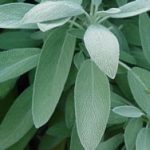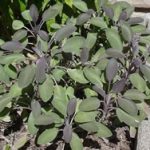Thanksgiving dinners filled with the fragrance of sage-dusted turkey and dressing may be an American tradition, so you may be surprised to find out that the sage plant (Salvia officinalis) is native to the Mediterranean.
Today sage is primarily used as a culinary herb, but in older times it was a common medicinal plant. The origin of the salvia name from the Latin salvus, “to save,” and salvere, “to heal,” underscores its medicinal value.
Sage is actually a diverse group of herbs belonging to the genus Salvia. Many species are well-adapted to the home garden. Common sage, S. officinalis, is grown for its leathery gray-green foliage on 1.5-2-foot-tall stems, which become slightly woody with age. Frequent cutting of the stems will encourage stronger new growth to emerge. Plants can be propagated by division, stem cuttings or seed. There are a number of cultivars available in variegated foliage colors: ‘Berggarten’ with its large, dusty blue-green leaves; ‘Tricolor’ with red, white and green leaves; ‘Purpurea’ in purple; and ‘Icterina’ with yellow-edged green leaves.
Sage performs best in full sun with well-drained soil. Garden sage will grow easily from seed, though harvest will be small the first year. After its second growing season, sage should be trimmed back in the spring to avoid the center of the plant becoming semi- woody.
If left to flower, sage will produce blue blooms that attract butterflies; however, this leaves less oil content, which results in reduced flavor in the leaves. Sage plants should provide a dependable supply of fresh-cut leaves for 3-5 years after which the plants should be replaced or divided to rejuvenate.

